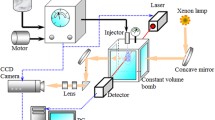Abstract
This paper describes the dynamic characteristics of pulsed, supersonic liquid fuel sprays or jets injected into ambient air. Simple, single hole nozzles were employed with the nozzle sac geometries being varied. Different fuel types, diesel fuel, bio-diesel, kerosene, and gasoline were used to determine the effects of fuel properties on the spray characteristics. A vertical two-stage light gas gun was employed as a projectile launcher to provide a high velocity impact to produce the liquid jet. The injection pressure was around 0.88–1.24 GPa in all cases. The pulsed, supersonic fuel sprays were visualized by using a high-speed video camera and shadowgraph method. The spray tip penetration and velocity attenuation and other characteristics were examined and are described here. An instantaneous spray tip velocity of 1,542 m/s (Mach number 4.52) was obtained. However, this spray tip velocity can be sustained for only a very short period (a few microseconds). It then attenuates very quickly. The phenomenon of multiple high frequency spray pulses generated by a single shot impact and the changed in the angle of the shock structure during the spray flight, which had already been observed in previous studies, is again noted. Multiple shock waves from the conical nozzle spray were also clearly captured.
Similar content being viewed by others
References
Nishida, K., Ochiai, H., Arai, M., Hiroyasu, H.: Characterization of diesel fuel spray by ultrahigh-pressure injection (in Japanese). Trans. JSME Part B 63(605), 344–349 (1997)
Hiroyasu, H.: Fundamental spray combustion mechanism and structures of fuel sprays in diesel engines. In: Chiu, H.H., Chigier, N.(eds) Mechanics and Combustion of Droplets and Sprays., pp. 237–260. Begell House, New York (1995)
Pianthong, K., Milton, B.E., Behnia, M.: Fundamentals of supersonic diesel fuel jets for use in diesel engine. In: Proceedings the 12th International Pacific Conference on Automotive Engineering, paper no. D08, Bangkok, Thailand (2003a)
Nakahira, T., Komori, M., Nishida, N., Tsujimura, K.: A study of shock wave generation around high pressure fuel spray in diesel engine. In: Shock Waves Proceedings, vol. 2, pp. 1271–1276. Sendai, Japan
Akiyama, H., Nishimura, H., Ibaraki, Y., Iida, N.: Study of diesel spray combustion and ignition using high-pressure fuel injection and a micro-hole nozzle with a rapid compression machine: improvement of combustion using low cetane number fuel. JSAE Rev. 19, 319–327 (1998)
Milton, B.E., Pianthong, K.: Pulsed, supersonic fuel jets: a review of their characteristics and potential for fuel injection. Int. J. Heat Fluid Flow 26(4), 656–671 (2005)
Field, J.E., Lesser, M.B.: On the mechanics of high speed liquid jets. Proc. R. Soc. Lond. A Series 357, 143–162 (1977)
Shi, H.H.: Study of hypersonic liquid jets, Ph.D. thesis, Tohoku University, Sendai, Japan (1994)
Delacourt, E., Desmet, B., Besson, B.: Characterisation of very high pressure diesel sprays using digital imaging techniques. Fuel 84, 859–867 (2005)
Desantes, J.M., Payri, R., Salvador, F.J., Gil, A.: Development and validation of theoretical model for diesel spray penetration. Fuel 85, 910–917 (2006)
Vogel, S., Hasse, C., Gronki, J., Andersson, S., Peters, N., Wolfrum, J., Schulz, C.: Numerical simulation and laser-based imaging of mixture formation, ignition, and soot formation in a diesel spray. Proc. Combust. Inst. 30, 2029–2036 (2005)
Hildenbrand, S., Staudacher, S., Bruggemann, D., Beyrau, F.: Numerical and experimental study of the vaporization cooling in gasoline direct injection sprays. Proc. Combust. Inst 31 (in press) (2007)
Billig, F.S.: Research on supersonic combustion. J. Propul. Power 9(4), 499–514 (1993)
Drummond, J.P., Carpenter, M.H., Riggins, D.W.: Mixing and mixing enhancement in high speed reactiing flows, high speed flight propulsion systems. Prog. Astronaut. Aeronaut. 7, 137 (1991)
Livingston, T., Segal, C., Schlinder, M., Vinogradov, V.A.: Penetration and spreading of liquid jets in an external-internal compression inlet. AIAA J 38(6), 898–994 (2000)
Pianthong, K., Zakrzewski, S., Behnia, M., Milton, B.E.: Supersonic liquid jets: their generation and shock wave characteristics. Shock Waves J. 11(6), 457–466 (2002)
Pianthong, K., Milton, B.E., Behnia, M.: Generation and shock wave characteristics of unsteday pulsed supersonic liquid jets. Atom Sprays 13(5–6), 475–498 (2003)
Pianthong, K., Takayama, K., Milton, B.E., Behnia, M.: Multiple pulsed hypersonic liquid diesel fuel jets driven by projectile impact. Shock Waves J. 14(1–2), 73–82 (2005)
Bowden, F.P., Brunton, J.H.: Damage to solids by liquid impact at supersonic speeds. Nature 181, 873–875 (1958)
Ohashi, K.: Experimental characterization of flow fields, Master Degree thesis, Tohoku University, Sendai (2002)
Matthujak, A., Pianthong, K., Sun, M., Takayama, K., Ikohagi, T.: Characteristics of high-speed liquid fuel jets. In: The 16th Japanese Symposium of Shock Wave, paper 19P10, Sendai (2005)
Matthujak, A., Hosseini, S.H.R., Takayama, K., Sun, M., Pianthong, K., Ikohagi, T.: Pressure measurement inside the nozzle during high-speed liquid jet generation. In: The 17th Japanese Symposium of Shock Wave, pp. 289–292, March 16–18, Yokohama (2006)
Author information
Authors and Affiliations
Corresponding author
Additional information
Communicated by K. Takayama.
Rights and permissions
About this article
Cite this article
Pianthong, K., Matthujak, A., Takayama, K. et al. Dynamic characteristics of pulsed supersonic fuel sprays. Shock Waves 18, 1–10 (2008). https://doi.org/10.1007/s00193-008-0123-4
Received:
Accepted:
Published:
Issue Date:
DOI: https://doi.org/10.1007/s00193-008-0123-4



